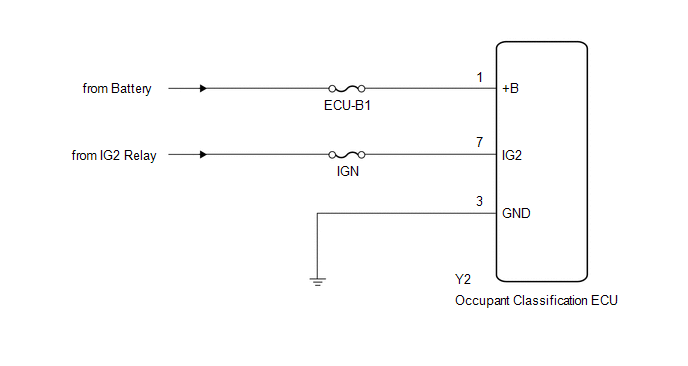DESCRIPTION DTC B1794 is set when a malfunction is detected in the occupant classification ECU.
HINT:
WIRING DIAGRAM 
CAUTION / NOTICE / HINT NOTICE:
PROCEDURE
(a) Turn the ignition switch to ON, and wait for at least 60 seconds. (b) Clear any DTCs stored in the memory (see page
HINT:
(c) Turn the ignition switch off, and wait for at least 10 seconds. (d) Turn the ignition switch to ON, and wait for at least 60 seconds. (e) Using the Techstream, check for DTCs of the occupant classification ECU (see
page OK: DTC B1794 is not output. HINT: DTCs other than DTC B1794 may be output at this time, but they are not related to this check.
(a) Turn the ignition switch off. (b) Disconnect the negative (-) terminal cable from the battery, and wait for at least 90 seconds. (c) Check that the connectors are properly connected to the center airbag sensor, occupant detection sensors and occupant classification ECU. OK: Connectors are properly connected.
(a) Check that the connectors (on the occupant classification ECU side) are not
damaged (see page OK: Connectors are not deformed or damaged.
(b) Disconnect the negative (-) terminal cable from the battery, and wait for at least 90 seconds. (c) Disconnect the Y2 ECU connector. (d) Connect the negative (-) terminal cable to the battery, and wait for at least 2 seconds. (e) Turn the ignition switch to ON, and wait for at least 60 seconds. (f) Measure the resistance and voltage according to the value(s) in the table below. Standard resistance:
Standard voltage:
(a) Turn the ignition switch off. (b) Disconnect the negative (-) terminal cable from the battery, and wait for at least 90 seconds. (c) Connect the connectors to the occupant classification ECU. (d) Connect the negative (-) terminal cable to the battery, and wait for at least 2 seconds. (e) Turn the ignition switch to ON, and wait for at least 60 seconds. (f) Clear any DTCs stored in the memory (see page
HINT:
(g) Turn the ignition switch off, and wait for at least 10 seconds. (h) Turn the ignition switch to ON, and wait for at least 60 seconds. (i) Using the Techstream, check for DTCs of the occupant classification ECU (see
page OK: DTC B1794 is not output. HINT: DTCs other than DTC B1794 may be output at this time, but they are not related to this check.
(a) Turn the ignition switch off. (b) Disconnect the negative (-) terminal cable from the battery, and wait for at least 90 seconds. (c) Replace the occupant classification ECU.
HINT: Perform the inspection using parts from a normal vehicle when possible.
(a) Connect the negative (-) terminal cable to the battery, and wait for at least 2 seconds. (b) Connect the Techstream to the DLC3. (c) Turn the ignition switch to ON, and wait for at least 60 seconds. (d) Using the Techstream, perform the zero point calibration (see page
(a) Using the Techstream, perform the sensitivity check (see page
Standard range: 27 to 33 kg (59.5 to 72.8 lb)
|
Toyota Tundra Service Manual > Door Lock: Door Control Receiver(for Double Cab)
Components COMPONENTS ILLUSTRATION *1 DOOR CONTROL AND TIRE PRESSURE MONITORING SYSTEM RECEIVER ASSEMBLY - - N*m (kgf*cm, ft.*lbf): Specified torque - - Installation INSTALLATION PROCEDURE 1. INSTALL DOOR CONTROL AND TIRE PRESSURE MONITORING SYSTEM RECEIVER ASSEMBLY (a) Attach the 2 guides to instal ...